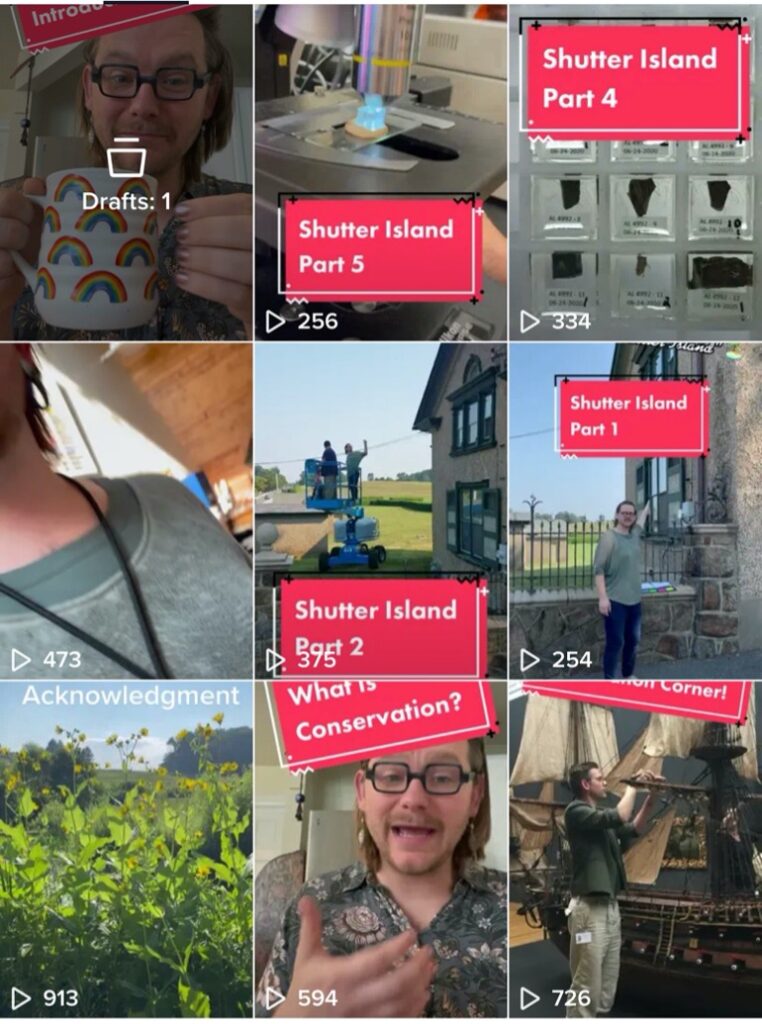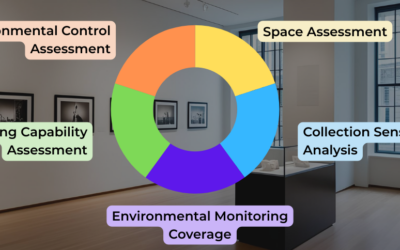This guest blog about shutter conservation at the Winterthur estate features a summary of a Summer Work Project by Riley Cruttenden, a graduate fellow at the Winterthur/University of Delaware Program in Art Conservation. Conserv provided funding to support student projects with a focus in preventive conservation. Learn more about our partnerships here.

Raised panel shutters on the first floor of the gatehouse, illustrating the poor condition of the paint. Photo credit: Riley Cruttenden
Over an eight-week period this summer I researched and analyzed architectural components of a circa 1902 gatehouse on the Winterthur Museum estate in New Castle County, Delaware. The focus of this examination was to improve our understanding of the house’s original wooden shutters. How were they painted over time? The paint is currently in poor condition: peeling, chalking, and delaminating, leaving exposed wood that is vulnerable to decay. What are viable options for preserving the shutters?
Choosing the right color for the shutter conservation proposal
The Winterthur estate historian and facilities team determined that the building should be restored to the way it appeared in the late 1960’s – the last portion of H. F. du Pont’s life, and the last period that he would have been involved in making aesthetic decisions about the property. No photographs or records document how the building appeared during that time. So, as Winterthur preserves and repaints the building’s shutters, what color should the shutters be painted?

Working with the Winterthur facilities team to sample from windows on the second story. Photo credit: Kathy Gillis
Working with Winterthur librarians, furniture and objects conservators, the facilities team, and conservation scientists, we were able to build evidence of how the gate house changed over time and provide guidance for care of the shutters. We identified five periods of paint on the shutters and even identified a painting firm and individual painters likely associated with those periods of paint.
With a reasonable degree of confidence, we have determined that the shutters were painted a deep, forest green with accents of very pale sage green during the late 1960’s.

Optical microscopy, brightfield, sample from shutter with 20 layers of paint. The thin green bands near the center of the sample date to the 1960’s and will be the color of the shutters moving forward. Photo credit: Riley Cruttenden

Back scatter electron image, sample from shutter with 20 layers of paint labelled. Photo credit: Catherine Matsen and Riley Cruttenden.
Testing, testing, testing
After improving our understanding of the buildup of paint over time, we proceeded to treatment testing. One of the treatment challenges with the shutters is the extensive use of lead pigments on earlier layers. The layers with lead are failing the most and creating a health and environmental hazard. With full OSHA safety recommendations in place, we tested removing the paint with solvents and with heat tools. Mechanical removal with the aid of heat, followed by solvent applications for residual paint worked the best.
We consulted colleagues at Colonial Williamsburg who care for many outdoor, painted structures to identify a high-performance paint with good color fastness and with minimal thickness. Minimizing the thickness of paint is essential for the maintenance of historic outdoor structures, as paint layers will become thick over time, obscure carved details, and create new problems. The results of our analysis and testing were compiled into a 30-page report, with condensed versions to follow. The goal of the condensed reports is to help provide justification to hire contractors to conduct thorough treatment and repainting of the shutters.

View of Tik Tok channel. Follow along @queer_conservation
Over the course of the summer, I also started a Tik Tok channel to highlight our work on the gate house. The channel features 1 to 3 minute videos that explain various steps of our project. The videos are aimed at a general audience, who may not be familiar with the field of conservation. In total, videos on the channel have received over 3,900 views. I have received communications on and off the app about what viewers have learned from the channel.
Final thoughts
Both the summer work project itself and sharing the project on Tik Tok have been deeply rewarding. With this analysis and the commitment of a very dedicated facilities team, I am optimistic that our recommended care plan will find funding and that the shutters will return to the deep green and pale green colors that they were painted under the discerning eye of H. F. du Pont.
Thank you very much, Conserv, for supporting the WUDPAC program and helping to make projects like this possible.





